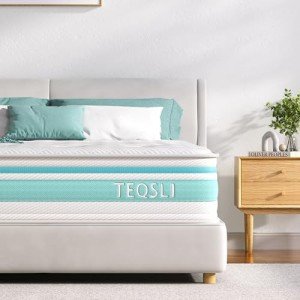The Benefits and Considerations of Memory Foam Mattresses
Memory foam mattresses have transformed the sleep market, offering a special combination of comfort and assistance that adjusts to the shapes of the body. Understood for their remarkable ability to alleviate pressure points, enhance comfort, and decrease motion transfer, these mattresses have actually become a popular choice for lots of individuals. This post digs into the different elements of memory foam mattresses, including their benefits, considerations, and skilled recommendations, helping customers make informed buying choices.
What is Memory Foam?
Memory foam, initially developed by NASA in the 1960s, is a viscoelastic product that complies with the body shape of the sleeper. It is understood for its distinct homes: high density and sluggish healing, enabling it to take in weight and disperse pressure equally while going back to its initial shape. This particular makes memory foam a perfect material for mattresses, providing assistance while lessening pain.
Advantages of Memory Foam Mattresses
Memory foam mattresses offer various advantages that contribute to better sleep quality:
- Pressure Relief: Memory foam contours to the shape of the body, relieving pressure on sensitive locations such as hips, shoulders, and joints.
- Spinal Alignment: Proper spinal alignment is vital for a great night's sleep. Memory foam mattresses offer balanced assistance, promoting a neutral spinal column position.
- Motion Isolation: Memory foam takes in and separates motion, making it an outstanding option for couples. Movement by someone generally does not disrupt the other, allowing both people to enjoy continuous sleep.
- Hypoallergenic Properties: Many memory foam mattresses are resistant to allergens, allergen, and mold, making them an ideal alternative for allergy victims.
- Sturdiness: High-quality memory foam mattresses can last longer than standard spring mattresses, keeping their shape and assistance with time.
Factors to consider When Choosing a Memory Foam Mattress
While memory foam mattresses have many advantages, possible buyers need to also understand particular factors to consider:
- Heat Retention: Memory foam can maintain heat, making some sleepers feel too warm. Lots of contemporary mattresses integrate cooling technologies, such as gel-infused foam or breathable covers, to alleviate this problem.
- Preliminary Odor: New memory foam mattresses can produce a preliminary chemical odor, typically known as off-gassing. This scent usually dissipates within a few days in a well-ventilated location.
- Weight: Memory foam mattresses can be heavy, making them challenging to move or establish without help.
- Firmness Variation: Different brand names and models provide numerous firmness levels. It is important to check a mattress's feel before buying to ensure it fulfills personal convenience preferences.
| Function | Memory Foam | Traditional Spring | Hybrid |
|---|---|---|---|
| Pressure Relief | Excellent | Fair | Great |
| Motion Isolation | Exceptional | Poor | Good |
| Heat Retention | Moderate | Low | Low |
| Spinal Alignment | Excellent | Fair | Great |
| Sturdiness | Great | Moderate | Good |
Kinds Of Memory Foam Mattresses
When exploring memory foam mattresses, it is very important to understand the various types available:
- Traditional Memory Foam: The original viscoelastic foam uniquely adheres to the body but may keep heat.
- Gel Memory Foam: Infused with gel particles, this foam supplies a cooler sleeping surface while maintaining contouring homes.
- Open-Cell Memory Foam: Designed with a structure that enables air to flow through, open-cell memory foam offers better breathability and reduces heat retention.
- Plant-Based Memory Foam: Made with particular natural plant oils, these foams go for a smaller ecological impact and can have much better breathability than standard foam.
Tips for Selecting a Memory Foam Mattress
When choosing a memory foam mattress, think about the following tips:
- Test Before You Buy: Try out the mattress in-store if possible or guarantee it comes with a sleep trial.
- Consider Your Sleep Position: Side sleepers might choose a softer firmness to reduce pressure on their shoulders and hips, while back and stomach sleepers may gain from a firmer mattress to preserve spinal positioning.
- Inspect Warranty and Return Policy: A good warranty can safeguard your investment, and a flexible return policy uses comfort.
- Research study Brands: Look for trusted brands with positive customer reviews and scores from independent sources.
Regularly Asked Questions (FAQs)
1. How long do memory foam mattresses last?Most high-quality memory foam mattresses have a life expectancy of 10 to 15 years with correct care. 2. Can memory foam mattresses be
flipped?Most memory foam mattresses are designed
to be single-sided and do not need turning. However, rotating the mattress can aid with wear. 3. Pressure-Relieving Memory Foam Mattress ?Yes, memory foam mattresses tend
to be much heavier than conventional spring mattresses due to their dense materials. 4. Can memory foam mattresses get too hot?Some people discover memory foam retains heat. Search for gel-infused or
open-cell foam alternatives for more breathability. 5. Exist funding choices for purchasing a memory foam mattress?Many retailers use financing strategies, enabling clients to break the total cost into manageable payments. Memory foam mattresses have emerged as a prominent choice for those seeking
convenience and assistance in their sleep environment. With a myriad of alternatives and functions offered, consumers can
successfully find the very best mattress to fulfill their needs. Understanding the advantages, considerations, and various kinds of memory foam will equip purchasers with the understanding to make a notified decision. As the demand for quality sleep continues to rise, memory foam mattresses will undoubtedly play a substantial function in improving sleep health and total wellness.

